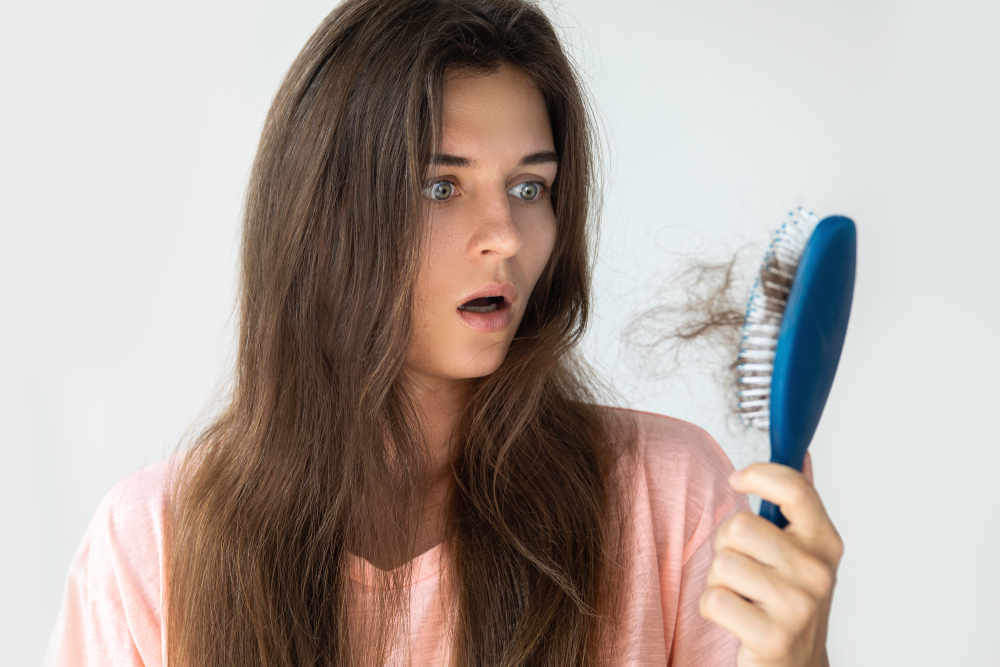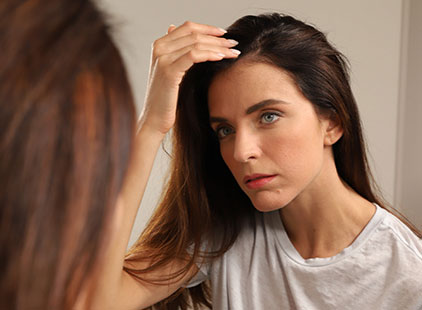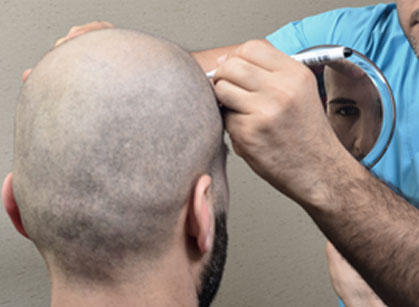The exact hair loss pattern varies from woman to woman. In some patients, the most affected area is the frontal one, with a progressive thinning in the central part of the hairline resulting in a triangular so-called “Christmas tree” part. In other cases, a central, scattered thinning takes place, generally sparing the hairline. A rarer case consists of a pattern that involves both loss of hair on the crown and a receding hairline on the forehead (more similar to male pattern hair loss).
Different methods have been conceived to classify female hair loss, the most famous being the Ludwig scale. Other commonly used scales are the Sinclair scale and the Savin scale.
If signs of inflammation, areas of scarring or scabs are visible on the scalp, it is possible to exclude other types of hair loss that could lead to this condition or be associated with female hair loss.
In the past, the term “androgenetic alopecia” was the first term ever used to refer to hair loss in both men and women. The term “andro” refers to the hormonal origin and “genetic” refers to the hereditary factor in the manifestation of the illness.
Over time, “female hair loss” has become the preferred term to describe this type of hair loss that afflicts women. This different terminology helps distinguish the characteristics of this process when compared to male pattern hair loss, and downsizes the role played by hormones, which are not always as fundamental as in the case of men.
Even if female hair loss can occur during any stage of life, it generally occurs after menopause. The progressive thinning of hair on the hairline and crown is due to the gradual reduction in the number of normal hairs compared to thinner ones.
This process is called follicular miniaturization. As part of this process, the duration of the hair growth phase (anagen) is continuously reduced from a normal duration of several years to just a few months or weeks. The mechanism behind this reduction has not yet been fully understood.
The crucial role of androgens and genetic predisposition are by now an established fact when speaking of male pattern hair loss. On the other hand, the degree to which these factors influence female hair loss is less clear. Male pattern hair loss is the consequence of the effect of dihydrotestosterone (a strong hormone deriving from testosterone) on the follicles. It is related to the androgen receptor on the follicles, which causes an increased activation of the genes responsible for the gradual transformation of normal hair into miniaturized hair. The loss typically spares the occipital area, and this specifically reflects the various levels of sensitivity to androgens of the different areas of the scalp. Some scholars have theorized that a similar mechanism contributes to female hair loss, supported by the fact that women affected by disorders involving hyperandrogenism (for example, polycystic ovary syndrome, ovarian hyperthecosis, ovarian tumours or androgen-secreting adrenal tumours) may develop premature hair loss. Nevertheless, the circulating androgen levels are normal in the majority of women afflicted by female hair loss, and thus this mechanism cannot entirely explain the cause of this type of hair loss. It has been hypothesized that women with normal levels of circulating androgens have hair follicles that are more sensitive to androgens. Moreover, the fact that female hair loss has a higher incidence with the increasing of the patient’s age, with the majority of cases occurring during menopause, suggests that estrogens play an important role in the process.
As far as the role of genetic predisposition in female hair loss is concerned, there are no clear patterns of family heredity; different genes seem to play a role in the loss.
Hair loss in a woman is often a source of stress and negative psycho-social behavior. Women suffering from hair loss have a negative perception of their image, a sense of impotence about their life and suffer from a reduced quality of life. This is heightened when adolescent girls experience the loss, as these individuals may suffer from problems at work, at school and in their interpersonal relationships. Moreover, the seriousness of these feelings does not always reflect the actual seriousness of the hair loss condition, but does reflect the degree of perception of the problem by the patient. The diagnosis of female hair loss is generally clinical, however a scalp biopsy may be necessary if other confusing signs of different types of hair loss are present or if the condition is atypical. Hormone testing allows hyperandrogenism and other contributing causes to be excluded as the cause of the problem. Clinical history and hair history may also be of help for formulating the diagnosis. If left untreated, female hair loss leads to progressive thinning, without usually resulting in complete baldness. Before starting any therapy, it is best to know what possible treatment are available, and to be aware of the importance of a consistent and long term adherence to the therapy, that it may involve a long period of time (several months) before providing any visible results and what the realistic goals of the therapy are. Above all, therapy is recommended to minimize further hair loss and induce regrowth in the follicles that are still alive. The results of treatments may vary enormously from case to case.
The first line drug with the greatest proof of effectiveness is topical use minoxidil. In addition to other qualities, this is a drug that ensures high safety standards. Minoxidil lengthens the growth phase of hair (anagen), reduces the terminal phase of hair (telogen) and can increase the diameter of miniaturized hair. At times its use must be interrupted due to sensitive, itchy skin.
Oral drugs that act as antiandrogens may be used as a second line therapy. These are taken with minoxidil or by themselves, when it is not possible to continue with minoxidil. These are finasteride, spironolactone, cyproterone acetate and flutamide, all of which can be used by women suffering from hyperandrogenism or who do not respond to minoxidil by itself. Nevertheless, the data on the effectiveness of these drugs is limited and not fully tested.
The surgical option of hair transplants from less affected areas may be evaluated in the case of women whose condition worsens and does not respond to treatments.
Other possible therapeutic options are:
– low level laser therapy (LLLT);
– topical use latanoprost 0.1% , a drug that simulates the effect of prostaglandins;
– topic use 17 alpha-estradiol, especially useful during menopause.

 English
English  Italiano
Italiano  Français
Français  Español
Español 



